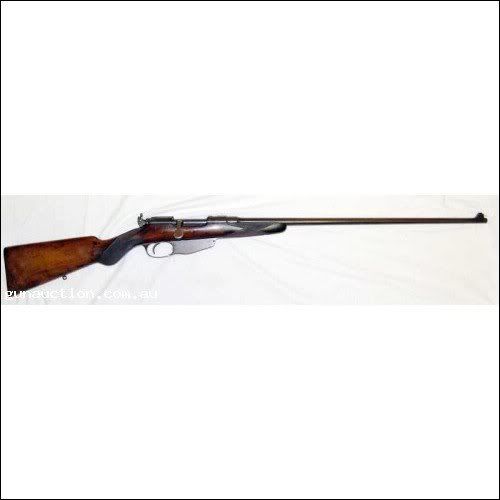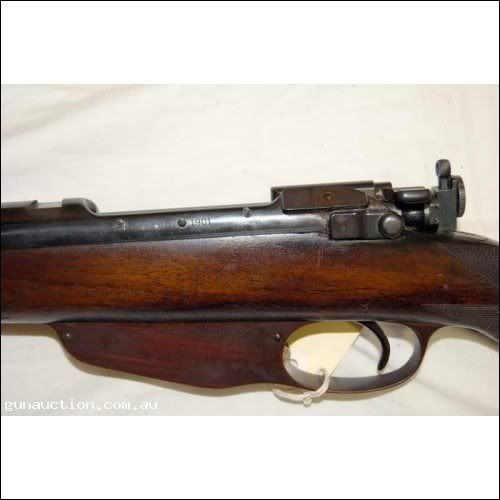Howdy,
I have experience with a rifle very similar to that -- a 6.5x53R Jefferey (London) sporter built on a Steyr 1898-marked action, with Lyman bolt peep sight and folding express sights. The bore was dark but strong, and slugged 0.268" on the grooves, but accuracy was fine with Hornady 160 gr. .264" RNSP bullets. Hobie is correct, brass can be formed from .303 British. I got to mike some original Dutch military 160 gr. FMJ's and also original German WW2 production steel case ammo, and both had bullets tapering from the front, increasing in diameter to .264". (In other words, they were not parallel-sided bullets of .264" diameter most of their length.) For that reason, I did not experiment with the .268" Hornady bullets; figured with the age of the rifle and its' value, I didn't want to do anything to increase pressures.
The rifle does take a steel en-bloc clip similar to a Carcano's, and the clip drops out of the action when the last round is chambered. They can be found, and range anywhere from $3.00 each to $15.00 each, depending on how badly the source wants to gouge you. Be careful how you load them; make sure the cartridge rims go in their corresponding slot in the back of the clip, and they will last a long time, being steel. If, in the loading/unloading process the lips get spread apart a bit, they are easily re-tensioned by hand. Original clips are blued steel, and usually are dated with a 2-digit date (example, 29 for 1929) and "AI" for Artillerie Inrichtigen, the Dutch arsenal. There may be other stamps also, but AI is on the ones I have seen. When you are out hunting, it can be helpful to put a strip of tape over the mag opening at the bottom to keep from losing your en-bloc clip when you chamber the last round (unless you're taking on dangerous game, of course!!)

There is a handy button which allows you to pop the remaining rounds/clip out of the action without having to cycle them through the rifle to unload.
By the way, German ammo I've seen is packed in 30-round brown, cardboard boxes; if you see one with a label over-stamp of "Fur MG," DON'T shoot it in your rifle, it's labeled for machine-gun use and may well be loaded hotter than standard rifle ammo.

RCBS charges about $300 for the case forming dies -- amazingly, a friend lucked into a set slightly used for much cheaper. The brass is easy to form, and in our experience, with OUR dies/chamber/brass, inside neck reaming was not necessary. (Although we tried using the reamer that comes with the form dies, it removed no brass). Some folks form the cases without forming dies, and some research on the net should help you on that procedure. Be sure to form them from NEW UNFIRED .303 brass, as the web area ahead of the rim may be too large on fired .303 brass to chamber in the Mannlicher. I believe Ken Waters covered this rifle model/caliber in his excellent book, "Pet Loads," under the old European/English name of .256 Mannlicher (used in the old days to help differentiate between the 6.5x53R and 6.5x54 MS.) In a worst-case scenario, Bertram Brass (Australia) does make the cases, although they are expensive (in the US, at least). The pressures are mild, however, and with careful handloading, the brass should last quite a long time.
It is a mild, very pleasant cartridge to shoot. While its' ballistics are essentially identical to the .30-30 (on paper) -- about 34 grains of powder, 160 gr. bullet, at about 2250 fps, the one I shot had basically NO recoil. It was truly astounding. The stock must play some part in the difference, I think -- you definitely notice a significant difference between a .30-30 Win 94 carbine and this 6.5x53R, even though the old sporters tend to run very lightweight. I just could not believe how little recoil there was with the Mannlicher. It worked very well on a feral hog culling operation. One fully-adrenalized wild hog (about 125 lbs) was running from left to right at about 15 yards range, full-tilt, and I put a 160 Hornady just over its front shoulder. It literally didn't take another step -- just hit the ground instantly and skidded to a halt on its' chin. There was about a 2-foot high plume of dust where the bullet went through and hit behind it, and while the exit hole was small, the hog was stone dead RIGHT THERE, RIGHT THEN. Needless to say, with its very long bullet and high sectional density, it out-penetrates a .30-30 effortlessly, and the cartridge has earned a good reputation for effectiveness afield far in excess of what you'd think from its' paper ballistics. Famed ivory hunter, W.D.M. Bell took a couple hundred elephant (IIRC, over 300, actually) with its' ballistic twin, the 6.5x54MS, until he decided to move up to a "heavier" rifle (7x57 Mauser with 175 gr. RN- FMJ's.)
If the bore's not damaged beyond repair (pay attention to the crown), I'd jump all over it, myself, if the price is even close to reasonable. It's a little extra work to get one of these up and running, but they are truly worth the effort. There's just nothing like hunting with one of these classic old-timers. I wouldn't worry about mild to moderate pitting of the bore, as long as the crown is good; I have seen bores that were eroded and mild-moderately pitted their full length shoot sub-MOA consistently with jacketed bullets.
They are really cool and, as always, if you buy it, you GOTTA post pics!!

Hope this helps,
John
"Pistols do not win wars, but they save the lives of the men who do. The noble 1911 is a mechanical marvel, whose ruggedness, dependability & ferocious power have comforted four issues of GIs and which, unlike any other instrument you can name, is as much superior to its rivals today as it was in 1917."
-Col. Jeff Cooper, 1968






